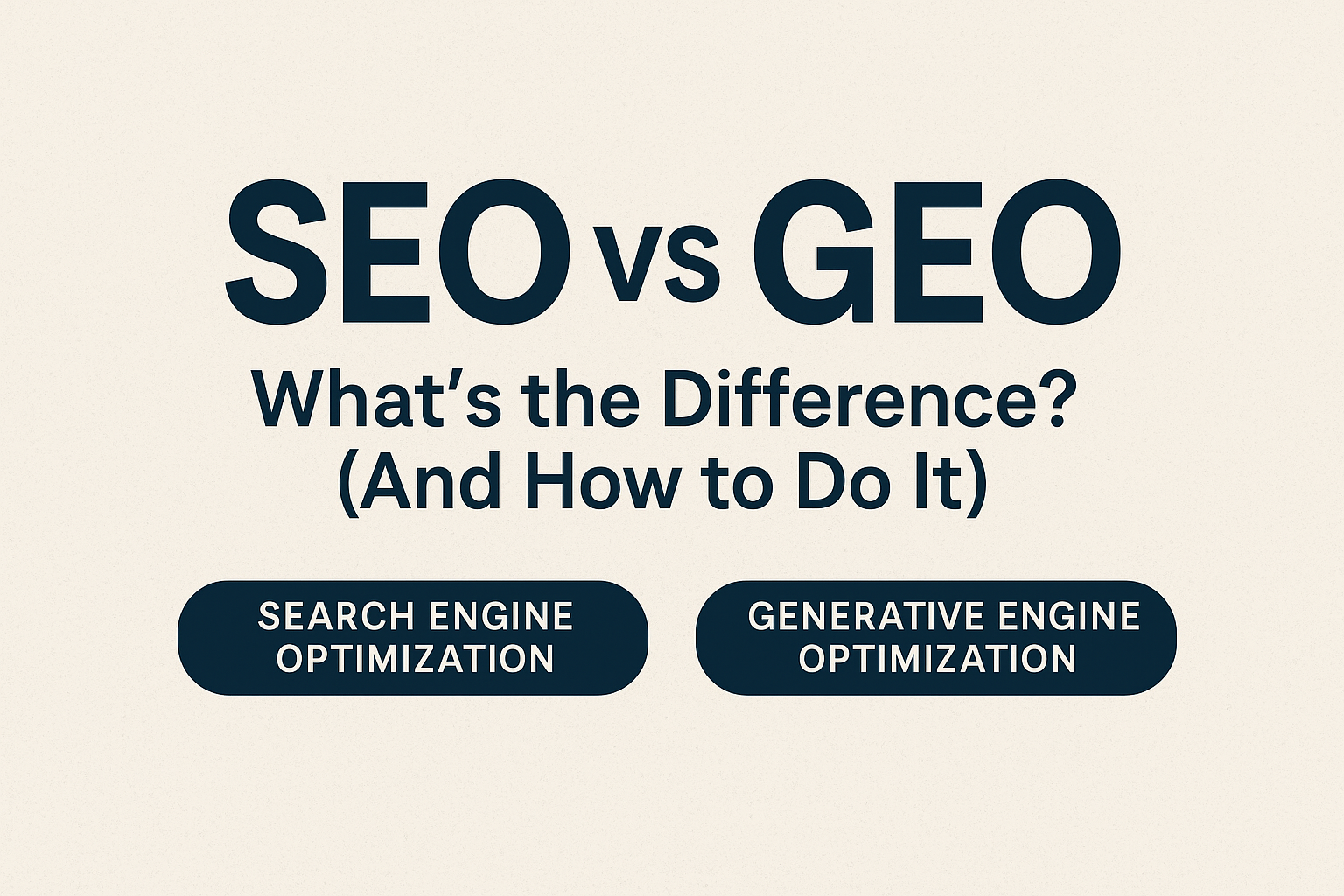As AI-generated answers become more prominent in search results, the landscape of digital visibility is changing fast. Traditionally, SEO (Search Engine Optimisation) has been the go-to practice for climbing Google’s rankings. But now there’s a new player in town: GEO - Generative Engine Optimisation.
In this article, we’ll explain the difference between SEO and GEO, why both matter, and how to build a strategy that gets you found in search engines and AI-generated answers like ChatGPT, Perplexity, and Google SGE.
What Is SEO?
SEO (Search Engine Optimisation) is the process of improving your website’s visibility in search engines like Google. It involves strategies like:
-
Keyword research
-
On-page optimisation (title tags, meta descriptions, content)
-
Technical SEO (page speed, mobile usability, structured data)
-
Backlinks and authority signals
The goal of SEO is to rank high in the organic search results when someone searches for something related to your website or business.
What Is GEO?
GEO (Generative Engine Optimisation) is the practice of optimising your content to be found, cited, or recommended by AI tools and Large Language Models (LLMs).
That includes:
-
Chatbots like ChatGPT and Claude
-
AI browsers like Perplexity
-
Generative answer engines like Google SGE and Bing Copilot
Unlike traditional search engines that crawl and rank websites based on links and keywords, generative engines look for contextually rich, fact-based, semantically structured content they can use to generate answers.
Learn more: How to Rank in ChatGPT (and Other AI Results)
SEO vs GEO: Key Differences
| Factor | SEO | GEO |
|---|---|---|
| Target | Search engines (Google, Bing) | AI engines (ChatGPT, Perplexity, SGE) |
| Goal | Rank in search results | Be cited or used in AI-generated answers |
| Key Techniques | Keywords, links, metadata | Entities, schema, clarity, citations |
| Content Format | Long-form, topic-focused | Fact-rich, entity-driven, AI-digestible |
| Measurement | Search rankings, traffic | Mentions in AI tools, citations, visibility in LLM answers |
Why GEO Matters More Than Ever
AI-generated results are already stealing clicks from traditional search. Google’s SGE, for instance, shows AI answers before organic listings. Tools like Perplexity never show the standard 10 blue links at all.
If your content isn’t GEO-optimised, you risk being left out of the AI-powered web entirely.
That’s why Semantic, our WordPress plugin, is designed specifically for AI-first optimisation. It auto-detects entities, adds the right schema, and helps ensure your pages are understood by both humans and machines.
👉 Learn more: Semantic WordPress Plugin
How to Optimise for SEO and GEO Together
You don’t need to choose between SEO and GEO. The best strategy is to combine both into a modern content approach.
Here’s how:
1. Focus on Entities, Not Just Keywords
Entities are the real-world things (people, places, concepts) your content is about. LLMs use them to understand and structure information.
Read this next: Why Entities Are the Secret to Better AI Optimisation (and How to Use Them)
2. Use Schema.org and Structured Data
Help both search engines and AI models understand your content by clearly marking up:
-
Articles
-
Products
-
FAQs
-
Authors
-
Organizations
3. Write Fact-Rich, Sourceable Content
Generative engines prefer content they can quote. Use clear statements, real data, dates, and avoid fluff.
4. Internal Linking for Context
Linking related pages together creates semantic depth and makes your site easier for crawlers (and AI models) to understand.
5. Test How You Appear in AI Tools
Regularly check how your site shows up in tools like:
-
Perplexity
-
ChatGPT (with browsing)
-
Google SGE (if available in your region)
We also have a handy free tool you can use, our AI Ranking Checker, where you can enter up to 5 search terms and see if your site is cited. Give it a go!
Closing Thoughts
SEO is still vital, but GEO is quickly becoming just as important. If you’re not optimising for both, you’re missing a growing share of visibility, traffic, and authority.
By combining structured SEO practices with AI-aware content design, you future-proof your digital presence.
Looking for an easy way to start? Try the Semantic WordPress Plugin - it’s built from the ground up for AI-first websites.
